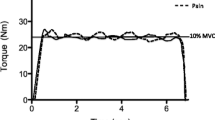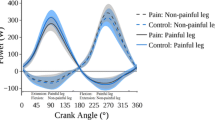Abstract
Knee pain is a common symptom of different knee pathologies, affecting muscle strength and force generation. Although the control of precise three-dimensional forces is essential for the performance of functional tasks, current evidence of pain effects in force variability is limited to single-directional assessments of contractions at moderate force levels. This study assessed the effects of experimental knee joint pain in the three-dimensional force variability during isometric knee extensions at a wide range of target forces (2.5–80 % of maximal voluntary contraction, MVC). Fifteen healthy subjects performed contractions before, immediately following, and after injections of hypertonic (painful) or isotonic (control) saline into the infrapatellar fat pad. Pain intensity was measured on a 10-cm visual analogue scale. Force magnitude, direction, and variability were assessed using a six-axis force sensor while activity of quadriceps and hamstring muscles was recorded by surface electromyography. Significant correlation was found between tangential force displacements and variability of quadriceps muscle activity. Experimental knee pain increased the variability of the task-related force component at all force levels, while variability of tangential force components increased at low forces (≤5 % of MVC). The mean quadriceps activity decreased during painful contractions only at 80 % of MVC. Pain adaptations underlying increased force variability at low contraction levels probably involve heterogeneous reorganization of muscle activity, which could not be detected by surface electrodes. These findings indicate a less efficient motor strategy during knee joint pain, suggesting that pain relief may enhance training for the control of smooth forces by knee pain patients.






Similar content being viewed by others
References
Bandholm T, Rasmussen L, Aagaard P, Jensen BR, Diederichsen L (2006) Force steadiness, muscle activity, and maximal muscle strength in subjects with subacromial impingement syndrome. Muscle Nerve 34:631–639
Bandholm T, Rasmussen L, Aagaard P, Diederichsen L, Jensen BR (2008) Effects of experimental muscle pain on shoulder-abduction force steadiness and muscle activity in healthy subjects. Eur J Appl Physiol 102:643–650
Bennell KL, Hinman RS, Metcalf BR, Crossley KM, Buchbinder R, Smith M, McColl G (2003) Relationship of knee joint proprioception to pain and disability in individuals with knee osteoarthritis. J Orthopaed Res 21:792–797
Bigland-Ritchie B, Woods JJ (1984) Changes in muscle contractile properties and neural control during human muscular fatigue. Muscle Nerve 7:691–699
Carville SF, Perry MC, Rutherford OM, Smith ICH, Newham DJ (2007) Steadiness of quadriceps contractions in young and older adults with and without a history of falling. Eur J Appl Physiol 100:527–533
Christou EA, Carlton LG (2002) Age and contraction type influence motor output variability in rapid discrete tasks. J Appl Physiol 93:489–498
Clockaerts S, Bastiaansen-Jenniskens YM, Runhaar J, Van Osch G, Van Offel JF, Verhaar JAN, De Clerck LS, Somville J (2010) The infrapatellar fat pad should be considered as an active osteoarthritic joint tissue: a narrative review. Osteoarthr Cartil 18:876–882
De Luca CJ, LeFever RS, McCue MP, Xenakis AP (1982) Behaviour of human motor units in different muscles during linearly varying contractions. J Physiol 329:113–128
Del Santo F, Gelli F, Spidalieri R, Rossi A (2007) Corticospinal drive during painful voluntary contractions at constant force output. Brain Res 1128:91–98
Dye SF, Vaupel GL, Dye CC (1998) Conscious neurosensory mapping of the internal structures of the human knee without intraarticular anesthesia. Am J Sport Med 26:773–777
Ervilha UF, Arendt-Nielsen L, Duarte M, Graven-Nielsen T (2004) Effect of load level and muscle pain intensity on the motor control of elbow-flexion movements. Eur J Appl Physiol 92:168–175
Farina D, Arendt-Nielsen L, Merletti R, Graven-Nielsen T (2004) Effect of experimental muscle pain on motor unit firing rate and conduction velocity. J Neurophysiol 91:1250–1259
Farina D, Negro F, Gizzi L, Falla D (2012) Low frequency oscillations of the neural drive to the muscle are increased with experimental muscle pain. J Neurophysiol 107:958–965
Felson DT (2005) The sources of pain in knee osteoarthritis. Curr Opin Rheumatol 17:624–628
Graven-Nielsen T, Lund H, Arendt-Nielsen L, Danneskiold-Samsøe B, Bliddal H (2002) Inhibition of maximal voluntary contraction force by experimental muscle pain: a centrally mediated mechanism. Muscle Nerve 26:708–712
Henriksen M, Rosager S, Aaboe J, Graven-Nielsen T, Bliddal H (2011) Experimental knee pain reduces muscle strength. J Pain 12:460–467
Hermens HJ, Freriks B, Disselhorst-Klug C, Rau G (2000) Development of recommendations for SEMG sensors and sensor placement procedures. J Electromyogr Kinesiol 10:361–374
Herrmann U, Flanders M (1998) Directional tuning of single motor units. J Neurosci Methods 18:8402–8416
Hodges PW, Ervilha UF, Graven-Nielsen T (2008) Changes in motor unit firing rate in synergist muscles cannot explain the maintenance of force during constant force painful contractions. J Pain 9:1169–1174
Hodges PW, Mellor R, Crossley K, Bennell KL (2009) Pain induced by injection of hypertonic saline into the infrapatellar fat pad and effect on coordination of the quadriceps muscles. Arthr Rheum 61:70–77
Hortobágyi T, Garry J, Holbert D, Devita P (2004) Aberrations in the control of quadriceps muscle force in patients with knee osteoarthritis. Arthritis Rheum 51:562–569
Kouzaki M, Shinohara M, Masani K, Fukunaga T (2004) Force fluctuations are modulated by alternate muscle activity of knee extensor synergists during low-level sustained contraction. J Appl Physiol 97:2121–2131
Kutch JJ, Kuo AD, Bloch AM, Rymer WZ (2008) Endpoint force fluctuations reveal flexible rather than synergistic patterns of muscle cooperation. J Neurophysiol 100:2455–2471
Lund JP, Donga R, Widmer CG, Stohler CS (1991) The pain-adaptation model: a discussion of the relationship between chronic musculoskeletal pain and motor activity. Can J Physiol Pharm 69:683–694
Madeleine P (2010) On functional motor adaptations: from the quantification of motor strategies to the prevention of musculoskeletal disorders in the neck–shoulder region. Acta Physiol 199:1–46
Madeleine P, Mathiassen SE, Arendt-Nielsen L (2008) Changes in the degree of motor variability associated with experimental and chronic neck–shoulder pain during a standardised repetitive arm movement. Exp Brain Res 185:689–698
Muceli S, Farina D, Kirkesola G, Katch F, Falla D (2011) Reduced force steadiness in women with neck pain and the effect of short term vibration. J Electromyogr Kinesiol 21:283–290
O’Reilly SC, Jones A, Muir KR, Doherty M (1998) Quadriceps weakness in knee osteoarthritis: the effect on pain and disability. Ann Rheum Dis 57:588–594
Pietrosimone BG, Saliba SA, Hart JM, Hertel J, Kerrigan DC, Ingersoll CD (2011) Effects of transcutaneous electrical nerve stimulation and therapeutic exercise on quadriceps activation in people with tibiofemoral osteoarthritis. J Orthop Sports Phys Ther 41:4–12
Pua YH, Clark RA, Bryant AL (2010) Physical function in hip osteoarthritis: relationship to isometric knee extensor steadiness. Arch Phys Med Rehabil 91:1110–1116
Remple MS, Bruneau RM, VandenBerg PM, Goertzen C, Kleim JA (2001) Sensitivity of cortical movement representations to motor experience: evidence that skill learning but not strength training induces cortical reorganization. Behav Brain Res 123:133–141
Salomoni SE, Graven-Nielsen T (2012a) Experimental muscle pain increases normalized variability of multidirectional forces during isometric contractions. Eur J Appl Physiol. doi:10.1007/s00421-012-2343-7
Salomoni SE, Graven-Nielsen T (2012b) Muscle fatigue increases the amplitude of fluctuations of tangential forces during isometric contractions. Hum Mov Sci. doi:10.1016/j.humov.2011.08.012
Schomburg ED, Steffens H, Kniffki KD (1999) Contribution of group III and IV muscle afferents to multisensorial spinal motor control in cats. Neurosci Res 33:195–206
Segal NA, Glass NA, Torner J, Yang M, Felson DT, Sharma L, Nevitt M, Lewis CE (2010) Quadriceps weakness predicts risk for knee joint space narrowing in women in the MOST cohort. Osteoarthr Cartil 18:769–775
Semmler JG, Tucker KJ, Allen TJ, Proske U (2007) Eccentric exercise increases EMG amplitude and force fluctuations during submaximal contractions of elbow flexor muscles. J Appl Physiol 103:979–989
Seynnes O, Hue OA, Garrandes F, Colson SS, Bernard PL, Legros P, Fiatarone SMA (2005) Force steadiness in the lower extremities as an independent predictor of functional performance in older women. J Aging Phys Act 13:395–408
Shinohara M, Moritz CT, Pascoe MA, Enoka RM (2005) Prolonged muscle vibration increases stretch reflex amplitude, motor unit discharge rate, and force fluctuations in a hand muscle. J Appl Physiol 99:1835–1842
Slemenda C, Heilman DK, Brandt KD, Katz BP, Mazzuca SA, Braunstein EM, Byrd D (1998) Reduced quadriceps strength relative to body weight: a risk factor for knee osteoarthritis in women? Arthr Rheum 41:1951–1959
Sørensen TJ, Langberg H, Hodges PW, Bliddal H, Henriksen M (2012) Experimental knee joint pain during strength training increases muscle strength gain in healthy subjects: a randomised controlled trial. Arthr Care Res 64:108–116
Tsao H, Hodges PW (2007) Immediate changes in feedforward postural adjustments following voluntary motor training. Exp Brain Res 181:537–546
Tucker KJ, Hodges PW (2010) Changes in motor unit recruitment strategy during pain alters force direction. Eur J Pain 14:932–938
Yao W, Fuglevand RJ, Enoka RM (2000) Motor-unit synchronization increases EMG amplitude and decreases force steadiness of simulated contractions. J Neurophysiol 83:441–452
Zhang W, Moskowitz RW, Nuki G, Abramson S, Altman RD, Arden NK, Bierma-Zeinstra S, Brandt KD, Croft P, Doherty M (2008) OARSI recommendations for the management of hip and knee osteoarthritis, part II: OARSI evidence-based, expert consensus guidelines. Osteoarthr Cartil 16:137–162
Zhang W, Gordon AM, Fu Q, Santello M (2010) Manipulation after object rotation reveals independent sensorimotor memory representations of digit positions and forces. J Neurophysiol 103:2953–2964
Acknowledgments
The study has been financed by Svend Andersen Fonden (Aalborg, Denmark).
Conflict of interest
The authors declare no conflicts of interest, financial or otherwise.
Author information
Authors and Affiliations
Corresponding author
Additional information
Communicated by Toshio Moritani.
Rights and permissions
About this article
Cite this article
Salomoni, S.E., Ejaz, A., Laursen, A.C. et al. Variability of three-dimensional forces increase during experimental knee pain. Eur J Appl Physiol 113, 567–575 (2013). https://doi.org/10.1007/s00421-012-2461-2
Received:
Accepted:
Published:
Issue Date:
DOI: https://doi.org/10.1007/s00421-012-2461-2




